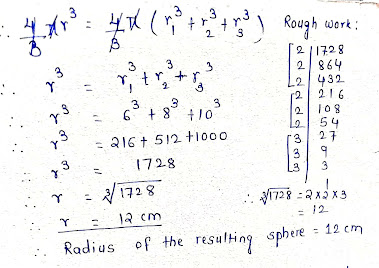CBSE Class 10 – Mathematics
Linear equations in
two variables MCQ
1.
The nature of the graph lines of the equations
5x – 2y + 9 = 0 and 15x – 6y + 1 = 0 will be
a.
Parallel
b.
Coincident
c.
Intersecting
d.
Perpendicular to each other
2. What will be the nature of the graph
lines of the equations 2x+5y+15 and 6x+15y+45?
a. Parallel
b. Coincident
c. Intersecting
d. Perpendicular to each other
3. What will be the value of k, if the
lines given by 3x+ky-4 and 5x+(9+k)y+41 represent two lines intersecting at a
point?
a. k ≠ 7/2
b. k ≠ 27/8
c. k = 27/2
d. k ≠ 27/2
4. What will be the value of k, if the
lines given by x+ky+3 and 2x+(k+2)y+6 are coincident?
a. 4
b. 2
c. 6
d. 8
5. The
lines 5x-7y=13 and 10x-14y=15 are
a. Consistent
b. Inconsistent
c. May
be consistent
d. None
of the above
6. If one equation of a pair of
dependent linear equations is -3x+5y-2=0. The second equation will be:
a. -6x+10y-4=0
b. 6x-10y-4=0
c. 6x+10y-4=0
d. -6x+10y+4=0
7. If
a pair linear equations is consistent then lines represented by them are
a. Parallel
b. Always
coincident
c. Always
intersecting
d. Intersecting or coincident
8. The values for which the pair of
equations (a – 1)x + 3y = 2 and 6x + (1 – 2b) = 6 has infinitely many solutions
are
a. a = -7, b = -4
b. a = -4, b = -7
c. a =3, b = -4
d. a = -4, b = 3
9. The pair of equations x + 2y + 5 = 0
and –3x – 6y + 1 = 0 have
a. a unique solution
b. exactly two solutions
c. infinitely many solutions
d. no solution
10. The pair of equations y = 0 and y =
–7 has
a. One solution
b. No solution
c. Two solutions
d. Infinitely many solutions
11. If the pair of linear equations has
a unique solution, then the lines representing these equations will
a. coincide
b. intersect at one point
c. parallel to each other
d. parallel to x-axis
12. The pair of equations x = a and y =
b graphically represents lines which are
a. Parallel to each other
b. Intersecting at point (a, b)
c. Intersecting at point (b, a)
d. Coincident
13. When lines l1 and l2
are coincident, then the graphical solution system of linear equations has
a. Infinitely many solutions
b. One solution
c. No solution
d. Unique solution
14. The graphical representation of a
pair of equations 4x + 3y + 1 = 6 and 12x + 9y = 15 will be
a. parallel lines
b. coincident lines
c. intersecting lines
d. perpendicular lines
15. The graph of x = –2 is
a. Parallel to x-axis
b. Parallel to y-axis
c. Passes through origin
d. Parallel to neither x-axis nor
y-axis
16. Which of the following is not a
solution of the pair of equations 3x – 2y = 4 and 6x – 4y = 8?
a. x = 2 and y = 1
b. x = 6 and y = 7
c. x = 5 and y = 3
d. x = 4 and y = 4
17. If the system of equations 2x + 3y =
7 and 2ax + (a+b)y = 28 has infinitely many solutions then
a. a = 2b
b. b = 2a
c. a + 2b = 0
d. 2a + b = 0
18. If x = a and y = b is the solution
of the pair of equations x – y = 2 and x + y = 4 then the values of a and b are
respectively
a. 3 and 5
b. 5 an 3
c. 3 and 1
d. -1 and -3
19. The angles of a triangle are x, y
and 40°. The difference between the two angles x and y is 30°. The
values of x and y are
a. 45°, 75°
b. 50°,
80°
c. 55°,
85°
d. 55°, 95°
20. If the sum of two numbers is 35 and
difference is 13 then the two numbers are
a. 24, 12
b. 24, 11
c. 13, 22
d. 28, 15
Answers:
1. a 2. b 3. d 4. b 5. b 6. a
7. d 8. c 9. d 10. b 11. b 12.
b
13. a 14. b 15.
b 16.
c 17.
b 18.
c
19. c 20. b






